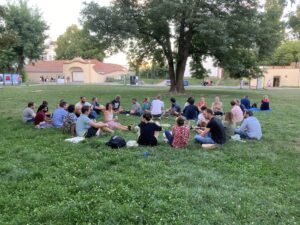Lydia Buckingham and Ben Ashby
Our new review article, ‘Coevolutionary theory of hosts and parasites’, was published in the February edition of JEB. In it, we give an overview of the theoretical literature on host-parasite coevolution and provide key insights about model assumptions, as well as considering recent developments and future directions.
Since Haldane first suggested that infectious diseases can drive natural selection for host resistance in 1949, a large field has developed to model host-parasite coevolution theoretically. These models make a wide range of assumptions about genetics and the environment, and are analysed using a variety of techniques (e.g. algebraically, numerically or through simulations). Comparison of such different models can be difficult, so in our review we highlight the key differences between models, explain their connections to biological systems and describe how their assumptions affect model outcomes and predictions.
Parasites have evolved diverse infection strategies to exploit their hosts, and hosts have evolved a broad range of defence mechanisms to cope with parasites. The genetics, ecology and environment of hosts and parasites can also vary greatly and this diversity can only be described by a wide range of different modelling assumptions.

But which assumptions are important? Some models assume that population sizes are constant, whereas others allow them to vary; they may assume that hosts and parasites have overlapping or non-overlapping generations; the genetic interactions between hosts and parasites may be modelled in many different ways, but most can be grouped according to how they deal with the “specificity” of which parasites can infect which hosts; random effects may be included or models may be deterministic; sometimes beneficial traits are assumed to carry costs, which may either be based on empirical work or chosen arbitrarily; and populations may be spatially-structured or well-mixed.
We analysed models from 219 published studies of host-parasite coevolution to understand the major differences between models and how these affect their outcomes and predictions. Most papers focus on when traits such as resistance and infectivity will evolve to be high or low (potentially through a coevolutionary “arms race” – see Figure 1), when populations diversify and whether traits or allele frequencies will fluctuate over time (see Figure 2).

Our analysis of the literature shows that it is important to consider certain modelling assumptions carefully as they can have significant effects on model outcomes. For example, fluctuating selection tends to be suppressed by population dynamics, but is promoted when parasites are highly specialised, or when generations are non-overlapping. Some modelling assumptions can also have contrasting effects depending on the circumstances, with stochasticity potentially inducing fluctuating selection (by amplifying damped oscillations) or disrupting it (by causing certain alleles to go extinct).
We also saw that there has been a trend towards increasing model complexity in recent years, especially in terms of more complex infection genetics (e.g. multi-step processes) and interactions with other species (e.g. host-parasite-predator or host-microbiome models). Models will likely continue to become more complex to capture more intricate community dynamics or to take advantage of new genomic data. However, complexity should not be pursued simply for complexity’s sake, and should be grounded in data from real biological systems where possible. Crucially, our review highlights the need to consider the effects of core modelling assumptions so that more complex scenarios can be properly understood.
*© Ben Ashby. Graphics by Ellie Harrison.




